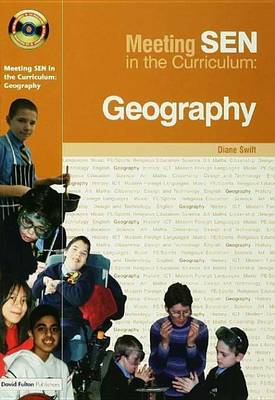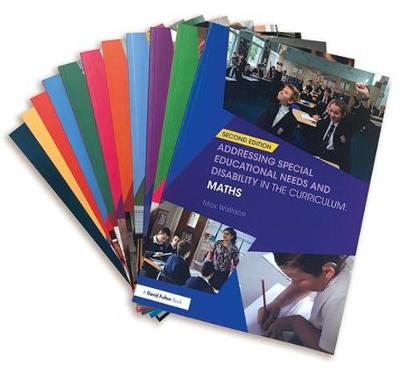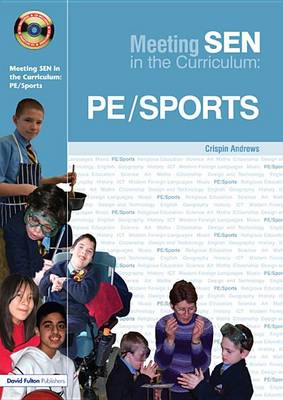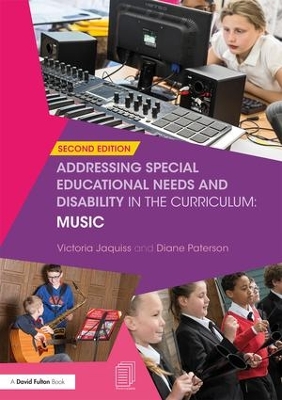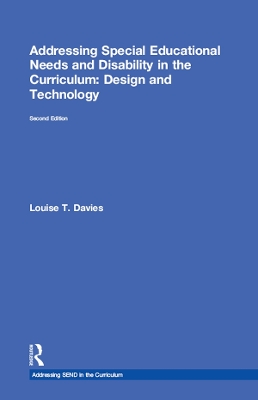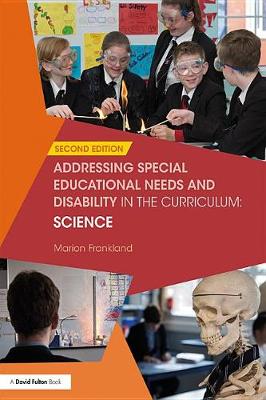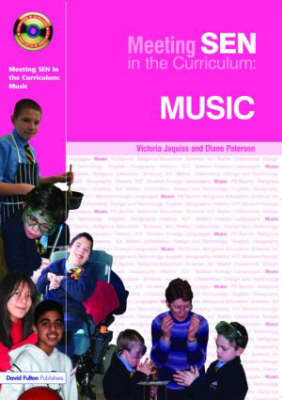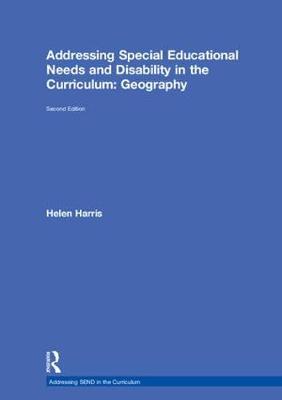Addressing SEND in the Curriculum
10 total works
All teachers are meeting more pupils with special needs in mainstream classrooms. Although there are general issues to be aware of subject specialists will always want specific guidance and examples. This series combines SEN expertise with subject knowledge to produce practical and immediate support. Covers: policy writing and how to do it; simple explanation of SEN labels; creating an inclusive classroom environment; monitoring and assessment; working with TAs; For secondary teachers, subjects Heads of Departments, SENCOs, Learning Support Departments and LEA advisers. This book includes: health and safety standards; selecting and using the right resources and materials; choosing the right teaching strategy to meet specific learning styles.
- an overview of SEN legislation and national initatives
- guidance on departmental policy
- advice on how to create an inclusive learning environment in the geography classroom and on field studies
- case study material
- good practice taken form the "Value Places" project.
Addressing Special Needs and Disability in the Curriculum 11 Book Set
by John Connor, Victoria Jaquiss, Diane Paterson, Crispin Andrews, Marion Frankland, Louise T. Davies, Ian Luff, Richard Harris, Dilwyn Hunt, and Helen Harris
The SEND Code of Practice (2015) reinforced the requirement that all teachers must meet the needs of all learners. This series offers specialist guidance for a full range of subjects in the upper primary and secondary curriculum; including English, Maths, Science, History, Geography, Languages, RE, Art, D&T, PE and Music. Each book draws on a wealth of experience and provides practical, tried and tested strategies and resources that will support teachers in delivering successful, inclusive lessons for all pupils.
An invaluable tool for continuing professional development, Addressing Special Educational Needs and Disabilities in the Curriculum will be essential for teachers and teaching assistants seeking subject specific guidance in supporting pupils with a wide range of learning needs. This series will also be of great interest to SENCOs, senior management teams and ITT providers.
Addressing Special Educational Needs and Disability in the Curriculum: Music
by Victoria Jaquiss and Diane Paterson
The SEND Code of Practice (2015) has reinforced the requirement that all teachers must meet the needs of all learners. This topical book provides practical, tried and tested strategies and resources that will support teachers in making music lessons accessible and exciting for all pupils, including those with special needs. The authors draw on a wealth of experience to share their understanding of special educational needs and disabilities and show how the music teacher can reduce or remove any barriers to learning.
Offering strategies that are specific to the context of music teaching, this book will enable teachers to:
- ensure all pupils are able to enjoy and appreciate music;
- find the appropriate musical instruments to suit the individual learner;
- develop approaches for teaching composition in mixed ability classrooms;
- provide opportunities for different types of performance;
- adapt content, approaches and resources for pupils with a wide range of learning needs.
An invaluable tool for continuing professional development, this text will be essential for teachers (and their teaching assistants) seeking guidance specific to teaching music to all pupils, regardless of their individual needs. This book will also be of interest to SENCOs, senior management teams and ITT providers.
In addition to free online resources, a range of appendices provides music teachers with lesson case studies, behaviour plans and guidance on behaviour management and effective teaching. This is an essential tool for music teachers and teaching assistants, and will help to deliver successful inclusive lessons for all pupils.
Addressing Special Educational Needs and Disability in the Curriculum: Design and Technology
by Louise T. Davies
The SEND Code of Practice (2015) reinforced the requirement that all teachers must meet the needs of all learners. This topical book provides practical, tried-and-tested strategies and resources that will support teachers in making design and technology lessons accessible and interesting for all pupils, including those with special educational needs. The author draws on a wealth of experience to share her understanding of special educational needs and disabilities and show how the design and technology teacher can reduce or remove any barriers to learning.
Offering strategies that are specific to the context of design and technology teaching, this book will enable teachers to:
- better identify a student's particular learning requirements;
- set inclusive design and making assignments which allow all students to participate and succeed;
- build students' confidence in using a range of materials and tools;
- assist with design tasks where pupils take ownership of their work and learning;
- adapt the classroom environment to meet the needs of pupils;
- create a mutually supportive classroom which maximises learning opportunities.
An invaluable tool for continuing professional development, this text will be essential for design and technology teachers (and their teaching assistants) seeking to include and motivate all pupils in their lessons, regardless of their individual needs. This book will also be of interest to secondary SENCOs, senior management teams and ITT providers.
In addition to free online resources, a range of appendices provide design and technology teachers with a variety of pro forma and activity sheets to support effective teaching. This is an essential tool for design and technology teachers and teaching assistants, and will help to deliver successful, inclusive lessons for all pupils.
Addressing Special Educational Needs and Disability in the Curriculum: Religious Education
by Dilwyn Hunt
The SEND Code of Practice (2015) reinforced the requirement that all teachers must meet the needs of all learners. This topical book provides practical, tried and tested strategies and resources that will support teachers in making RE lessons accessible and interesting for all pupils, including those with special needs. The author draws on a wealth of experience to share his understanding of special educational needs and disabilities and show how the RE teacher can reduce or remove any barriers to learning.
Offering strategies that are specific to the context of RE teaching, this book will enable teachers to:
- create a supportive environment which maximises learning opportunities;
- plan the classroom layout and display to enhance learning;
- help students of all levels to gain confidence in their reading and writing ability;
- stimulate discussion and develop thinking skills through using stimuli such as religious art, music, artefacts and films;
- successfully train and fully use the support of their teaching assistants.
An invaluable tool for continuing professional development, this text will be essential for teachers (and their teaching assistants) seeking guidance specific to teaching RE to all pupils, regardless of their individual needs. This book will also be of interest to SENCOs, senior management teams and ITT providers.
In addition to free online resources, a range of appendices provide RE teachers with a variety of writing frames and activity sheets to support effective teaching. This is an essential tool for RE teachers and teaching assistants, and will help to deliver successful, inclusive lessons for all pupils.
Addressing Special Educational Needs and Disability in the Curriculum: Science
by Marion Frankland
The SEND Code of Practice (2015) reinforced the requirement that all teachers must meet the needs of all learners. This topical book provides practical, tried and tested strategies and resources that will support teachers in making science lessons accessible and exciting for all pupils, including those with special needs. The author draws on a wealth of experience to share her understanding of special educational needs and disabilities and show how science teachers can reduce or remove any barriers to learning.
Offering strategies that are specific to the context of science teaching, this book will enable teachers to:
- help all students develop their 'evidence-gathering' skills and aid their scientific discovery by involving the use of all of the senses and structuring tasks appropriately;
- create a supportive environment that maximises learning opportunities;
- plan the classroom layout and display to enhance learning;
- use technology to adapt lessons to the needs of individual pupils;
- successfully train and fully use the support of their teaching assistants.
An invaluable tool for continuing professional development, this text will be essential for teachers (and their teaching assistants) seeking guidance specific to teaching science to all pupils, regardless of their individual needs. This book will also be of interest to SENCOs, senior management teams and ITT providers.
In addition to free online resources, a range of appendices provide science teachers with a variety of writing frames and activity sheets to support effective teaching. This is an essential tool for science teachers and teaching assistants, and will help to deliver successful, inclusive lessons for all pupils.
This book includes: making sure that instruments are accessible to all; how to teach musical notations; coordinating and supervising individual and group work.
Addressing Special Educational Needs and Disability in the Curriculum: Geography
by Helen Harris
The SEND Code of Practice (2015) reinforced the requirement that all teachers must meet the needs of all learners. This topical book provides practical, tried and tested strategies and resources that will support teachers in making geography lessons accessible and interesting for all pupils, including those with special needs. The author draws on a wealth of experience to share her understanding of individual needs and show how the geography teacher can reduce or remove any barriers to learning.
Offering strategies that are specific to the context of geography teaching, this book will enable teachers to:
- ensure all pupils are able to participate in every lesson;
- provide inclusive fieldwork opportunities that take into consideration the needs of all pupils;
- use formative assessments to measure learning and inform planning;
- plan the classroom layout and display to enhance learning;
- successfully use the support of their teaching assistants.
An invaluable tool for continuing professional development, this text will be essential for middle school and secondary geography teachers (and their teaching assistants) who are committed to creating an inclusive learning environment for all pupils, regardless of their individual needs. The book will also be of interest to SENCOs and inclusion managers, curriculum co-ordinators, senior management teams and ITT providers.
Full of practical ideas and inspiration, and supported by free online resources, this is an essential tool for geography teachers and teaching assistants who want to deliver successful, inclusive lessons for all pupils.

